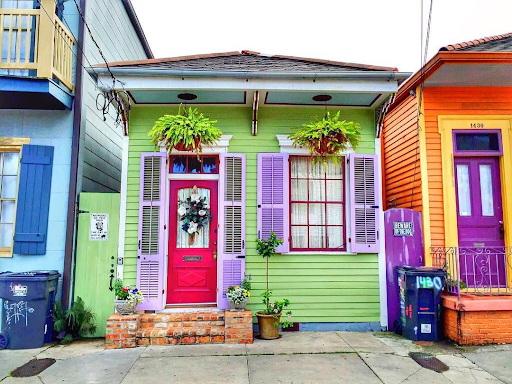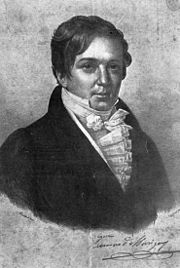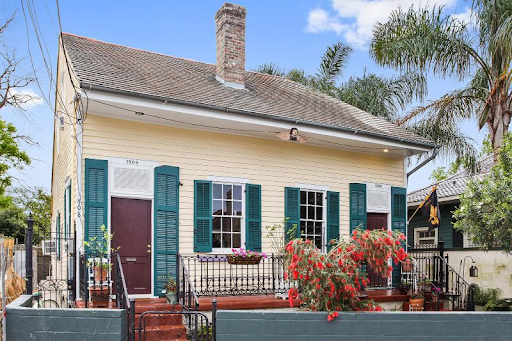Include a Topper!
-
Happy Birthday Banner
$9.00
Add Ons
Your cart is currently empty!


People from all around the globe come to enjoy New Orleans every year.
Whether they prefer a scenic streetcar ride up the live oak lined avenue of St. Charles or a slow stroll through the Vieux Carre, what many visitors don’t know is a place as charming and picturesque rests just outside the French Quarter. It’s called the Faubourg Marigny and its history is as delightfully colorful as the houses nestled along its streets.
To understand the vibrant yet homey feel of the Faubourg Marigny, one has to look back at its founder. Jean-Bernard Xavier Philippe de Marigny de Mandeville, in addition to having a most impressive name, was a plantation owner, playboy, duelist, politician, land developer, and notorious gambler. It was de Marigny who introduced the game of Craps to New Orleans just a few years before he created the first subdivided neighborhood in the city.
De Marigny might have been just another bon vivant after inheriting his father’s substantial wealth in 1799. But his caretakers were determined to see the 14-year-old better himself and sent him for extended mercantile training in Pensacola, Florida and London, England. De Marigny didn’t take to the mercantile business and returned to New Orleans in 1802, bringing both the dice game “crapaud” and a few big ideas back with him.
Beginning in 1805, de Marigny, now 20, petitioned the city to allow him to sub-divide his land located just outside of the Vieux Carre. With the French Quarter dangerously overpopulated, the city council approved de Marigny’s idea almost immediately, and people flocked to buy the new lots and begin building homes. Within two years, he’d sold 68% of the lots at a profit of around $80,000 or just over $2 million in today’s money.
When the Haitian slave revolt began in 1809, thousands of refugees fled to New Orleans. Many of them bought lots in the predominantly French speaking Faubourg Marigny, particularly free women of color and their slaves. The Haitian refugees also brought the now famous Creole Cottage design with them and, in just a few years, these four-room homes dotted the Marigny’s landscape alongside shotgun houses and the more prominent American mansions.

De Marigny took great pride in his self-named neighborhood, even going so far as to name many of the streets himself. These included, Good Children (now St. Claude Ave.), Elysian Fields (after Paris’ Champs-Elysees), and Craps (changed to Burgundy St. after much protesting from four scandalized churches located on the street). He was also forward thinking enough to hire an architect to implement a rotated grid system for the suburb. This system accounted for a 135 degree turn in the Mississippi River, allowing “mother streets” like Royal, Chartres, and Bourbon to continue through the Marigny with no interruptions.
Elysian Fields was the first street in New Orleans to run from Lake Pontchartrain to the Mississippi River. In 1830, de Marigny sold the land running through the middle of the avenue to the newly formed Pontchartrain Railroad. The next year, the railroad opened a line which operated solely between Milneburg, a fishing village on Lake Pontchartrain, and the Faubourg Marigny. The steam engine, Smokey Mary, was the most famous train to haul goods and people from Pontchartrain Beach to the river along Elysian Fields from 1831 to 1930.
Beginning in 1914, more affluent home owners began to vacate the Marigny for neighborhoods where they would be able to install indoor plumbing. The homes they left behind became low rent housing and the Marigny became known as a working-class neighborhood. Following WWII, Black veterans were able to purchase homes in the Marigny due to the lower costs. Unfortunately, this set off a wave of “white flight” which led to further decline in home values and increasing urban blight.
It wasn’t until the 1970s that things began to turn round once again for the
suburb. Young professionals and couples saw the charm and affordability of the Creole Cottages and shotgun houses and soon were renovating these homes with determination and brightly colored paint. The formation of the Faubourg Marigny Improvement Association led to the neighborhood achieving nationally recognized historic status in 1974.
Today’s Marigny is an eclectic and diverse neighborhood filled with artists and poets living side by side with plumbers and doctors. There are numerous bars, restaurants, and theatres catering to every possible taste. So, the next time you’re downtown for a visit or running an errand, take a moment and wander through the history filled Faubourg Marigny. I’m sure Bernard de Marigny would be happy you did.
